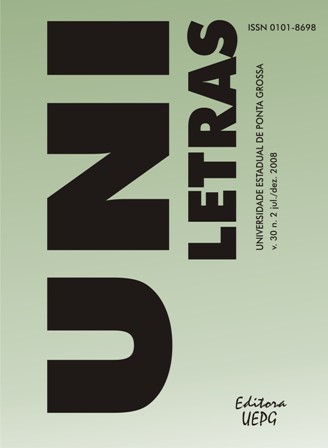A FINALIDADE DA ESCRITA NO LIVRO DIDÁTICO: MARCAS NO GÊNERO DISCURSIVO - Doi: http://dx.doi.org/10.5212/Uniletras.v.30i2.317333
DOI:
https://doi.org/10.5212/uniletras.v30i2.520Abstract
Ao considerar que todo enunciado deve possuir uma razão para ser produzido, os comandos de produção textual dos livros didáticos de Língua Portuguesa de 5ª a 8ª séries foram analisados, para se observar como apresentam ao aluno uma finalidade para a realização da escrita em sala de aula. As análises e sistematizações dos dados produziram uma taxonomia das finalidades encontradas, sendo que, neste artigo, apresentam-se os comandos analisados que possuem uma finalidade marcada no gênero discursivo e num de seus elementos, o meio de circulação dos textos. Os resultados demonstram que, enquanto em muitos comandos, a finalidade foi concebida como sendo o próprio meio de circulação, proporcionando, assim, uma escrita artificial; em outros, o gênero discursivo e a finalidade se uniram, promovendo uma produção de texto mais próxima da realidade social do aluno.
Palavras-chave: Escrita. Finalidade. Gênero discursivo. Livro didático.
This study analyzed requests for textual productions in Portuguese Language textbooks for High School students with regard to the manner in which the aims for writing in the classroom are highlighted. This is mandatory, since any enunciation needs underpinning in order to be productive. Although data analyses and systematizations have yielded a taxonomy of aims, only requests with aims marked on the speech genre are provided in this article. Results show that, while in some requests the aims were seen as a means of circulation, thus resulting in an artifi cial writing, in others the speech genre and the aims were united, resulting in a textual production closer to the students` social reality.
Keywords: Writing. Requests. Aims. Textbook.
Downloads
Downloads
Issue
Section
License
Authors that publish in the journal agree with the following terms:
a) The authors keep the copyright and grant to the journal the rights of the first publication, with the work simultaneously being licensed under the Creative Commons Attribution License that allows the sharing of the work with the recognition both of the authorship and the initial publication in this journal.
b) This journal provides immediate public access to all of its content, following the principle that making scientific knowledge freely available to the public provides greater worldwide democratization of knowledge. For more information about this approach, visit Public Knowledge Project, a Project that developed this system to improve the academic and public quality of research, distributing OJS as well as other softwares to support the publication system to public/open access to academic sources. Names and e-mail addresses in this website will be used exclusively for this journal purposes, not being available for other ends.

This work is licensed under a Creative Commons Attribution 4.0 International License.





